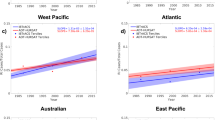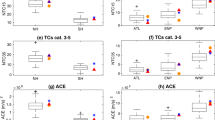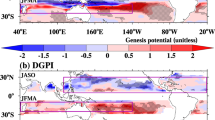Abstract
Long-term observations have revealed large amplitude fluctuations in the frequency and intensity of tropical cyclones (TCs; refs 1, 2, 3, 4), but the anthropogenic impacts, including greenhouse gases and particulate matter pollution4,5, remain to be elucidated. Here, we show distinct aerosol effects on the development of TCs: the coupled microphysical and radiative effects of anthropogenic aerosols result in delayed development, weakened intensity and early dissipation, but an enlarged rainband and increased precipitation under polluted conditions. Our results imply that anthropogenic aerosols probably exhibit an opposite effect to that of greenhouse gases, highlighting the necessity of incorporating a realistic microphysical–radiative interaction of aerosols for accurate forecasting and climatic prediction of TCs in atmospheric models.
This is a preview of subscription content, access via your institution
Access options
Subscribe to this journal
Receive 12 print issues and online access
$209.00 per year
only $17.42 per issue
Buy this article
- Purchase on Springer Link
- Instant access to full article PDF
Prices may be subject to local taxes which are calculated during checkout




Similar content being viewed by others
References
Emanuel, K. A. Increasing destructiveness of tropical cyclones over the past 30 years. Nature 436, 686–688 (2005).
Webster, P. J., Holland, G. J., Curry, J. A. & Chang, H. R. Changes in tropical cyclone number, duration, and intensity in a warming environment. Science 309, 1844–1846 (2005).
Holland, G. J. & Webster, P. J. Heightened tropical cyclone activity in the North Atlantic: Natural variability or climate trend? Phil. Trans. R. Soc. A 365, 2695–2716 (2007).
Knutson, T. R. et al. Tropical cyclones and climate change. Nature Geosci. 3, 157–163 (2010).
Rosenfeld, D. et al. Aerosol effects on microstructure and intensity of tropical cyclones. Bull. Amer. Meteorol. Soc. 93, 987–1001 (2012).
Emanuel, K. A. Downscaling CMIP5 climate models show increased tropical cyclone activity over the 21st century. Proc. Natl Acad. Sci. USA 110, 12219–12224 (2013).
Dunstone, N. J., Smith, D. M., Booth, B. B., Hermanson, L. & Eade, R. Anthropogenic aerosol forcing of Atlantic tropical storms. Nature Geosci. 6, 534–539 (2013).
Zhang, R. et al. Intensification of Pacific storm track linked to Asian pollution. Proc. Natl Acad. Sci. USA 104, 5295–5299 (2007).
Li, G., Wang, Y., Lee, K-H., Diao, Y. & Zhang, R. Increased winter precipitation over the North Pacific from 1984–1994 to 1995–2005 inferred from the Global Precipitation Climatology Project. Geophys. Res. Lett. 35, L13821 (2009).
Wang, Y., Zhang, R. & Saravanan, R. Asian pollution climatically modulates mid-latitude cyclones following hierarchical modelling and observational analysis. Nature Commun. 5, 3098 (2014).
Fan, J., Zhang, R., Li, G. & Tao, W-K. Effects of aerosols and relative humidity on cumulus clouds. J. Geophys. Res. 112, D14204 (2007).
Mann, M. E. & Emanuel, K. A. Atlantic hurricane trends linked to climate change. Eos Trans. 87, 233–244 (2006).
Lau, K. M. & Kim, K.-M. How nature foiled the 2006 hurricane forecasts. Eos Trans. 88, 105–107 (2007).
Dunion, J. P. & Velden, C. S. The impact of the Saharan air layer on Atlantic tropical cyclone activity. Bull. Am. Meteor. Soc. 85, 353–365 (2004).
Zhang, H., McFarquhar, G. M., Saleeby, S. M. & Cotton, W. R. Impacts of Saharan dust as CCN on the evolution of an idealized tropical cyclone. Geophys. Res. Lett. 34, L14812 (2007).
Khain, A. P., Cohen, N., Lynn, B. & Pokrovsky, A. Possible aerosol effects on lightning activity and structure of hurricanes. J. Atmos. Sci. 65, 3652–3677 (2008).
Carrió, G. G. & Cotton, W. R. Investigations of aerosol impacts on hurricanes: Virtual seeding flights. Atmos. Chem. Phys. 11, 2557–2567 (2011).
Zhang, H., McFarquhar, G. M., Cotton, W. R. & Deng, Y. Direct and indirect impacts of Saharan dust acting as cloud condensation nuclei on tropical cyclone eyewall development. Geophys. Res. Lett. 36, L06802 (2009).
Rosenfeld, D., Khain, A., Lynn, B. & Woodley, W. L. Simulation of hurricane response to suppression of warm rain by sub-micron aerosols. Atmos. Chem. Phys. 7, 3411–3424 (2007).
Li, G., Wang, Y. & Zhang, R. Implementation of a two-moment bulk microphysics scheme to the WRF model to investigate aerosol–cloud interaction. J. Geophys. Res. 113, D15211 (2008).
Fan, J. et al. Effects of aerosol optical properties on deep convective clouds and radiative forcing. J. Geophys. Res. 113, D08209 (2008).
Levy, M. et al. Measurements of submicron aerosols in Houston, Texas during the 2009 SHARP field campaign. J. Geophys. Res. 118, 10518–10534 (2013).
Bates, T. S. et al. Boundary layer aerosol chemistry during TexAQS/GoMACCS 2006: Insights into aerosol sources and transformation processes. J. Geophys. Res. 113, D00F01 (2008).
Zhang, F., Weng, C. Y., Sippel, J. A., Meng, Z. & Bishop, C. H. Cloud-resolving hurricane initialization and prediction through assimilation of Doppler radar observations with an ensemble Kalman filter. Mon. Weat. Rev. 137, 2105–2125 (2009).
Komaromi, W. A., Majumdar, S. J. & Rappin, E. D. Diagnosing initial condition sensitivity of Typhoon Sinlaku and Hurricane Ike. Mon. Weat. Rev. 139, 3224–3242 (2008).
Fan, J. et al. Microphysical effects determine macrophysical response for aerosol impacts on deep convective clouds. Proc. Natl Acad. Sci. USA 110, E4581–E4590 (2013).
Hawkins, H. F. & Imbembo, S. M. The structure of a small, intense hurricane—Inez 1966. Mon. Weat. Rev. 104, 418–442 (1976).
Khain, A. P., Lynn, B. & Dudhia, J. Aerosol effects on intensity of landfalling hurricanes as seen from simulations with WRF model with spectral bin microphysics. J. Atmos. Sci. 67, 365–384 (2010).
Lin, N. H. et al. An overview of regional experiments on biomass burning aerosols and related pollutants in Southeast Asia: From BASE-ASIA and the Dongsha Experiment to 7-SEAS. Atmos. Environ. 78, 1–19 (2013).
Lau, K. M. & Zhou, Y. P. Observed recent trends in tropical cyclone rainfall over the North Atlantic and the North Pacific. J. Geophys. Res. 117, D03104 (2012).
Fan, J. et al. Simulations of cumulus clouds using a spectral microphysics cloud resolving model. J. Geophys. Res. 112, D04201 (2007).
Wang, M. et al. The multi-scale aerosol-climate model PNNL-MMF: Model description and evaluation. Geosci. Model Dev. 4, 137–168 (2011).
Zhao, C. et al. Aircraft measurements of cloud droplet spectral dispersion and implications for indirect aerosol radiative forcing. Geophys. Res. Lett. 33, L16809 (2006).
Acknowledgements
Y.W. was supported by a NASA graduate fellowship in Earth Sciences. R.Z. acknowledges support from the Ministry of Science and Technology of China under award number 2013CB955800. We thank K.A. Emanuel, P. Liss, C. Schumacher and F. Zhang for helpful discussions. Supercomputing computational facilities were provided by the Texas A&M University. Y.W. acknowledges additional support by the NASA ROSES COUND program at the Jet Propulsion Laboratory, California Institute of Technology, under contract with NASA.
Author information
Authors and Affiliations
Contributions
K.L., Y.W. and R.Z. designed the research. K.L. and Y.W. conducted the research (performed the model simulations and analysed the data). Y.W., Y.L. and M.L. performed additional ensemble simulations and analysis. Y.W. and R.Z. wrote the manuscript.
Corresponding authors
Ethics declarations
Competing interests
The authors declare no competing financial interests.
Supplementary information
Rights and permissions
About this article
Cite this article
Wang, Y., Lee, KH., Lin, Y. et al. Distinct effects of anthropogenic aerosols on tropical cyclones. Nature Clim Change 4, 368–373 (2014). https://doi.org/10.1038/nclimate2144
Received:
Accepted:
Published:
Issue Date:
DOI: https://doi.org/10.1038/nclimate2144
This article is cited by
-
Roles of Atmospheric Aerosols in Extreme Meteorological Events: a Systematic Review
Current Pollution Reports (2022)
-
Hemisphere-asymmetric tropical cyclones response to anthropogenic aerosol forcing
Nature Communications (2021)
-
Direct/indirect effects of aerosols and their separate contributions to Typhoon Lupit (2009): Eyewall versus peripheral rainbands
Science China Earth Sciences (2021)
-
Tropical cyclone precipitation in the HighResMIP atmosphere-only experiments of the PRIMAVERA Project
Climate Dynamics (2021)
-
Sea-Salt Aerosol Effects on the Simulated Microphysics and Precipitation in a Tropical Cyclone
Journal of Meteorological Research (2019)



